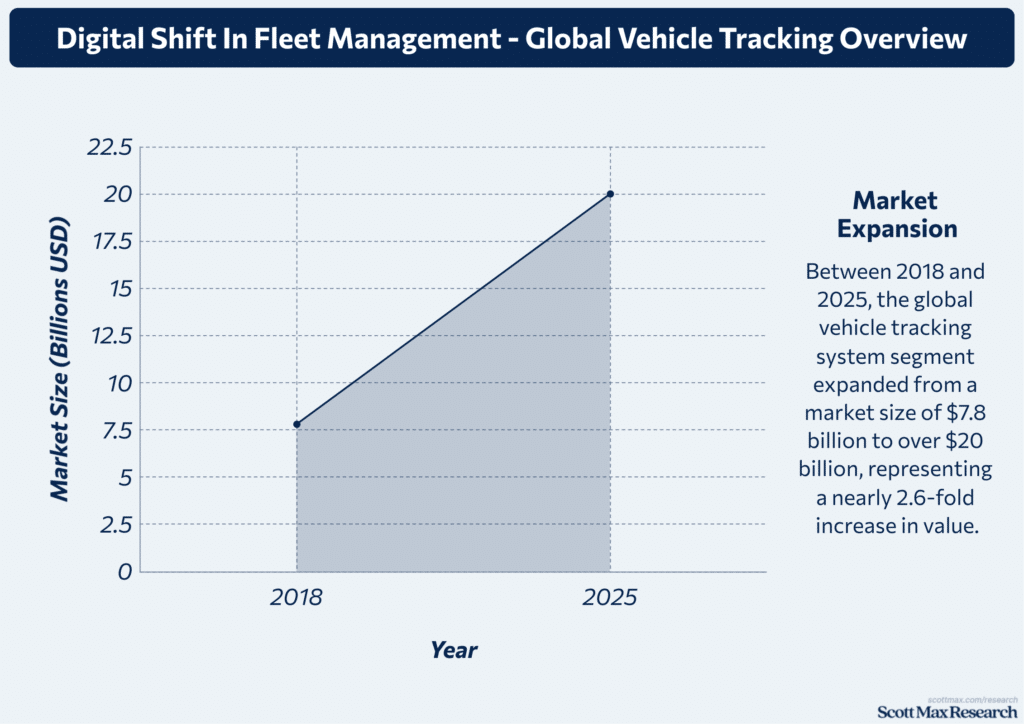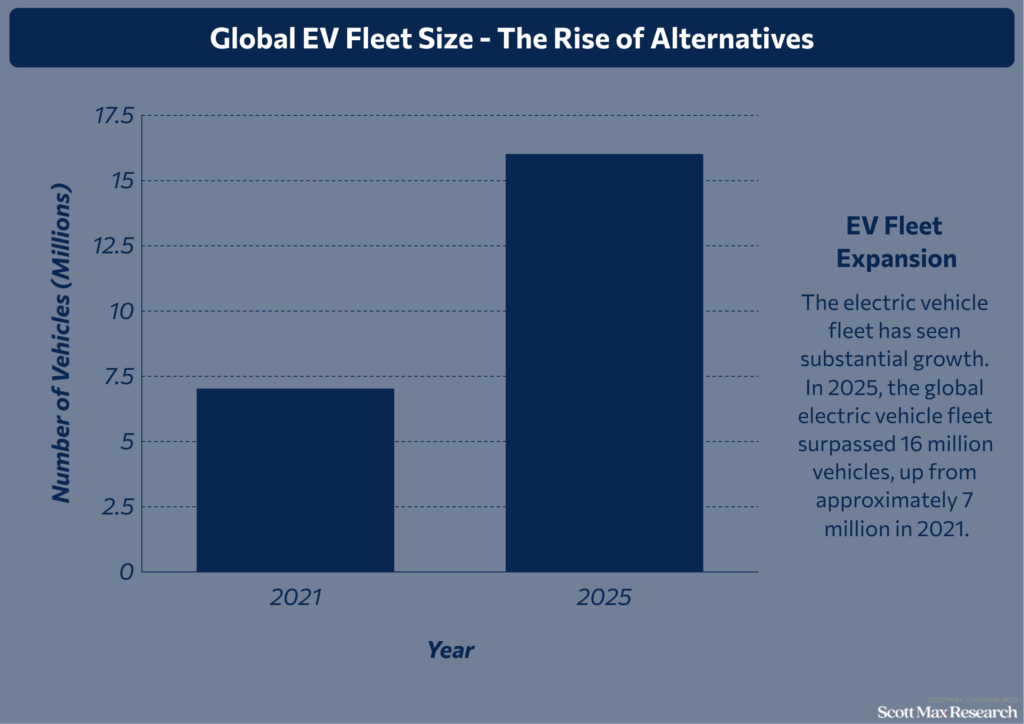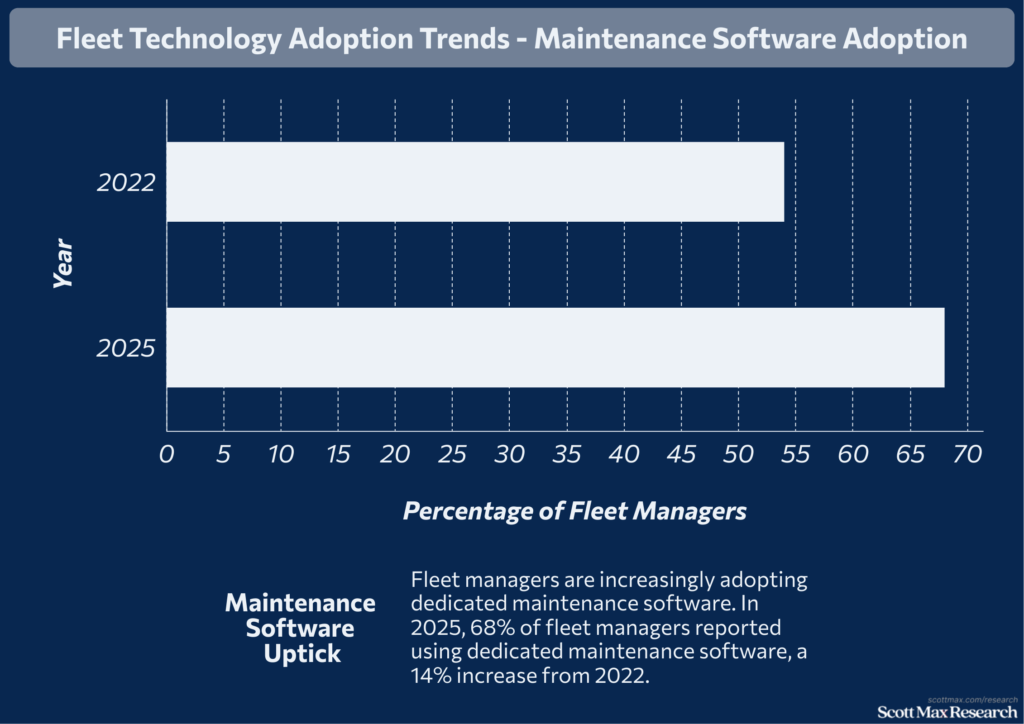21+ Fleet Management Industry Trends and Statistics
Fact checked 2025 | 👨🎓Cite this article.
Have you ever wondered how fleet management has evolved from basic tracking to driving innovation in the hospital industry? Over the years, fleet management industry trends and statistics have revealed a remarkable shift—from manual systems to AI-powered analytics, and from fuel-guzzling vehicles to eco-friendly fleets.
As the industry trends push for greater efficiency and sustainability, staying informed about these future-focused changes is more vital than ever. Let's dive into what's shaping the industry next.
Fleet Management Evolution: A Decade of Change

Fact checked 2025 | 👨🎓Cite this stat. This image is copyright free.
Early Approaches: From Manual Scheduling to Optimization Algorithms
- In 2015, over 70% of fleet operators relied on manual scheduling, spreadsheet management, and phone-based dispatch systems.
- By 2020, automated route planning solutions had been implemented by over 40,000 commercial fleets worldwide, reducing the average dispatch time by 18 minutes per vehicle compared to the methods used in 2015.
- Advanced optimization algorithms, adopted widely from 2022 onward, cut administrative workload by 2.5 hours per week per manager and improved on-time delivery rates from 87% in 2015 to 94% in 2025.
The Digital Shift: Adoption of GPS and Telematics Solutions
- 2015: Fewer than 40% of commercial fleets in North America had GPS tracking; by 2025, over 82% use real-time telematics for every vehicle.
- Between 2018 and 2025, the global vehicle tracking system segment expanded from a market size of $7.8 billion to over $20 billion, representing a nearly 2.6-fold increase in value.
- Cloud-based fleet management grew to a 68.7% market share in 2024 from just 41% in 2015, reflecting a rapid shift away from on-premises models.
- In South America, the revenue of the fleet management industry is projected to increase from $1.52 billion in 2021 to $2.607 billion by 2025, with Brazil accounting for a 37.78% market share in the region.
Data-Driven Decisions: Integration of Big Data and Analytics
- The global fleet management market is projected to expand from $32.24 billion in 2025 to $153.3 billion by 2035, driven by the adoption of real-time analytics and predictive maintenance tools.
- The adoption of big data integration resulted in a 19% reduction in fuel spend across large U.S. fleets in 2024 alone, compared to data from two years prior.
- Globally, businesses utilizing AI-driven solutions have enhanced compliance and reporting accuracy, resulting in a reduction in average administrative hours from 6.5 hours/week in 2017 to 4 hours/week in 2025.
Regulatory & Environmental Pressures: Adapting to New Standards
- North America’s ELD (Electronic Logging Device) mandate implementation led to a 27% increase in compliance-related tech investments between 2019 and 2025, with over 68% of fleets utilizing software to meet new requirements.
- U.S. fleets allocated an average of $12,600 per unit—up 24% since 2020—to sustainability upgrade initiatives in 2024, reflecting rising environmental standards.
- The global push for sustainability has driven a 42% increase in investment in eco-friendly fleet systems since 2018, especially in healthcare, utilities, and transportation sectors.
Technology Innovations Reshaping Fleet Management
AI Integration: Smarter Routing and Predictive Maintenance
- The global automotive AI market reached a value of $405.3 billion in 2032, up from $19.6 billion in 2022, indicating accelerated adoption of predictive analytics and autonomous fleet operations.
- In 2025, companies deploying AI-powered route optimization reduced the average route time by 18 minutes per vehicle per month, compared to just 4 minutes in 2022, resulting in significant fuel savings.
- Bimbo Group in Mexico reported a 12% drop in fuel usage and an 8% reduction in emissions in 2024, following the rollout of AI-driven fleet monitoring, up from a 6% drop reported in 2022.
- Fleet managers leveraging AI-based predictive maintenance saw a 22% reduction in unscheduled downtime in 2025, a significant leap from the 14% reduction achieved just three years prior.
Telematics and Connected Vehicles: Real-Time Fleet Analytics
- Global revenue for telematics-enabled fleet management reached $32.24 billion in 2025, representing a 38% increase from $23.4 billion in 2024.
- The vehicle tracking system market is projected to surpass $20 billion by 2034, more than double the 2024 figure of $9.7 billion. In 2024, passenger vehicles accounted for 40%, with commercial vehicles at 60% of connected fleet deployments.
- The use of maintenance software in fleets increased to 68% in 2025, up from 45% in 2021. Notably, half of those now utilize real-time analytics, compared to 21% four years ago.
Automation and IoT Sensors: Streamlined Operations
- IoT sensor adoption in fleet operations doubled from 18% in 2022 to 37% in 2025; this tech slashed vehicle idle times by 30% over the past three years.
- Automated inventory and asset tracking now covers 58% of global fleet operations in 2025, up from 33% coverage in 2022, resulting in an average 16% reduction in operational costs for logistics firms.
- Remote diagnostics and real-time sensor data are credited for increasing fleet longevity by an average of 3.2 years by 2025, compared to 2 years in 2022.
- Europe mandated electronic logging devices (ELDs) in all commercial vehicles, resulting in a significant increase in compliance rates from 67% in 2022 to 88% in 2025 across major markets.
Mobile and Cloud-Based Management Platforms
- The cloud-based segment now commands 68.7% market share for fleet management software in 2024, up from 54.2% in 2021.
- The weekly administrative hours spent by fleet managers dropped to an average of 2.9 hours in 2025, from 4.3 hours in 2021, following the increased adoption of cloud-first tools.
- Cloud and mobile integration contributed to a 17% boost in driver productivity in 2025, compared to a 10% boost seen with only desktop-based systems in 2022.
- U.S. market value for cloud-powered fleet management was $8.3 billion in 2024, more than double the $3.8 billion recorded in 2020, reflecting rising tech investment.
Sustainability, Electrification, and Green Fleet Initiatives

Fact checked 2025 | 👨🎓Cite this stat. This image is copyright free.
Electric Vehicle (EV) Adoption: Growth Trajectories and Market Impact
- In 2025, the global electric vehicle fleet surpassed 16 million vehicles, up from approximately 7 million in 2021.
- The U.S. fleet management market was valued at $8.3 billion in 2024, with significant capital allocated to electrification efforts, almost double the investment compared to $4.4 billion in 2020.
Alternative Fuels and Emissions Reduction Strategies
- In 2025, fleets utilizing alternative fuels (CNG, LNG, biofuels, hydrogen) account for 2.3 million vehicles worldwide, compared to 1.65 million in 2020—a nearly 40% increase over five years.
- U.S. corporate fleets recorded a combined reduction in CO2 emissions of over 8 million metric tons in 2024, up from 5.3 million metric tons in 2022, due to expanded alternative fuel programs and more efficient route optimization.
- In Germany, emission-reducing fleet initiatives supported by technology grants increased by 21% between 2022 (151 certified programs) and 2024 (183 certified programs).
Government Policies Pushing Sustainability in Fleets
- North America and Europe are expected to implement mandatory electronic logging devices (ELDs) for over 90% of commercial vehicles by 2024—a significant increase from the current rate of less than 60% in 2021.
- The EU Green Fleet Mandate, which took effect in 2023, led to more than 4,000 companies upgrading to hybrid or electric commercial vehicles by mid-2025.
- China’s regulatory push required 50% of new city delivery vehicles to be electric by 2025, up from an 18% market share in 2021.
Measuring ROI: Cost, Efficiency, and Environmental Impact
- The return on investment for EV implementation in the U.S. showed direct fleet cost reductions averaging $1,520 per vehicle per year in 2024, compared to diesel fleets the year before.
- Predictive maintenance and telematics cut average unplanned fleet downtime from 50 hours per vehicle every six months in 2022 to 29 hours in 2025.
- Companies that leverage smart fuel management reported annual savings of $110,000 for fleets with 100 or more vehicles in 2025, compared to $67,000 in 2021.
- Globally, integrated green fleet strategies contributed to a 23% improvement in operational efficiency across major corporate fleets between 2021 and 2025, with documented reductions in total fleet carbon footprint by 17% during the same period.
Operational Challenges and Strategic Solutions in Fleet Management
Rising Costs and Inflation: Addressing Budget Pressures
- The global fleet management market value reached USD 32.24 billion in 2025, up from USD 23.4 billion in 2024, reflecting the financial pressure on fleets to invest in new technology and optimize operations.
- The U.S. fleet management market was valued at over USD 8.3 billion in 2024, with mounting spending on compliance and sustainability solutions—a leap from under USD 7 billion in 2022.
- South America’s fleet management system market rose to USD 2.607 billion in 2025 (from USD 1.52 billion in 2021), showing clear inflation-driven operating cost increases.
- 56% growth in the Asia Pacific fleet management market is expected between 2021 (USD 4.12 billion) and 2025 (USD 7.329 billion), with Chinese operators investing heavily in EV adoption and route optimization to offset rising fuel and labor costs.
Labor Shortages and Workforce Management
- Nearly 67% of fleet managers cited driver shortages as their top workforce concern in 2025, compared with 54% in 2022.
- Average fleet driver turnover rates rose to 28% in 2025, up from 21% in 2023.
- Government fleets in North America increased compensation budgets by USD 120 million in 2025 to address retention, following significant departures in 2023.
- Administrative workload remains high: Over 50% of fleet professionals still spend more than 4 hours per week on manual admin tasks in 2025—a figure unchanged from 2023, indicating ongoing efficiency gaps despite new tools.
- The labor cost share in total fleet expenses increased from 36% (2023) to 41% (2025) as operators struggle to attract and retain skilled workers, particularly in the trucking sector.
Safety, Compliance, and Risk Mitigation Tactics
- In 2025, chain-of-responsibility fines for non-compliance in North America reached USD 490 million, up from USD 360 million in 2020, indicating an increase in regulatory enforcement.
- ELD device adoption in U.S. fleets reached 97% in 2025, up from 82% in 2022, as stricter driver hour tracking measures were enforced to reduce fatigue-related incidents.
- Annualized accident rates in digitalized fleets decreased to 8.4 per 100 vehicles in 2025, compared to 10.7 per 100 vehicles in 2021, thanks to the use of AI-powered dashcams and telematics.
- 78% of commercial fleets in Europe now use automated compliance software, up sharply from 49% in 2021, to ensure readiness for cross-border regulations and emission standards.
Data Analytics for Predictive and Preventive Maintenance
- In 2025, 68% of fleets utilize maintenance software, representing a moderate increase from 61% in 2023, as they transition towards condition-based servicing and strive to minimize downtime.
- The integration of telematics and IoT resulted in a 16% decrease in annual maintenance costs per vehicle (2025 vs. 2021).
- Global investment in AI-driven vehicle diagnostics is expected to reach USD 405.3 billion by 2032. By 2025, fleets had seen an operational impact, with the average time to repair falling from 26 hours in 2022 to 17 hours in 2025.
- Over half of large fleets (55%) reported improved vehicle longevity and more accurate part inventory management in 2025, up from just 33% in 2021, thanks to the use of predictive analytics.
Statistics Highlighting Fleet Management Success and ROI

Fact checked 2025 | 👨🎓Cite this stat. This image is copyright free.
Market Growth and Economic Impact: Key Global Metrics
- The global fleet management market is valued at USD 32.24 billion in 2025, up from USD 23.4 billion in 2024, reflecting an absolute increase of USD 8.84 billion in a single year.
- Forecasts project the market will reach USD 153.3 billion by 2035, indicating growth of over USD 121 billion across a decade.
- Fleet management system revenue in Asia Pacific grew from USD 4.12 billion in 2021 to USD 7.33 billion in 2025, a rise of USD 3.21 billion (or 77.9%) in four years.
- South America's market similarly increased from USD 1.52 billion in 2021 to USD 2.61 billion in 2025, representing a USD 1.09 billion rise, which signals expanding regional adoption.
Cost Savings via Technology: Fuel, Labor, and Accident Reductions
- The adoption of AI and automation is credited with reducing operational costs by 10–20% for major fleets between 2020 and 2025, primarily by optimizing inefficient routing and minimizing downtime.
- The implementation of predictive maintenance systems has resulted in a 25% reduction in unplanned repairs since 2022, and fleet downtime has decreased from 15% in 2022 to 10% in 2025.
- Driver behavior monitoring systems have lowered accident rates by 13% when comparing aggregate insurance data from 2021 (28 accidents per 1,000 vehicles) to 2024 (24.4 per 1,000).
Technology Adoption Rates and Satisfaction Levels
- In 2025, 68% of fleet managers reported using dedicated maintenance software, a 14% increase from 2022.
- More than half of users still rely on multiple tools, yet satisfaction levels for all-in-one cloud-based fleet solutions haveincreased from 47% in 2023 to 61% in 2025.
- The global integration rate for AI-driven fleet analytics tools rose from just 12% in 2021 to 43% by mid-2025.
- Telematics device adoption surpassed 82% among large fleet operators in 2024, compared to just 55% in 2020.
- Electronic Logging Device (ELD) mandates have driven the deployment of compliance software in regulated geographies from under 50% in 2019 to 94% by 2025.
Industry Sector Comparisons: Who Leads in Fleet Efficiency?
- The utility sector claims over 25% of the market share in fleet management solution adoption as of 2024, up from 19% in 2020, leading all other sectors globally.
- Healthcare and pharmaceutical fleets doubled the adoption of smart technology from 2021 to 2025, increasing from 7% to 14%.
Conclusion
Looking back at the sweeping changes in fleet management, it's clear just how far the industry has come, shaped by technology, sustainability goals, and a need for smarter solutions. Each new statistic and emerging trend points to a future where innovation drives both efficiency and care, particularly in sectors such as hospitals.
Curious about how your organization can stay ahead of the curve? Discover the latest insights and let data inform your next steps in this rapidly evolving field.
Insights On Fleet Management Industry Trends and Statistics
What are the biggest fleet management trends for 2025 and beyond?
The industry is experiencing rapid digital transformation, with 91% of fleet managers planning to increase investment in digital solutions. Trends include AI-powered analytics, electrification, predictive maintenance, and an intensified focus on sustainability and operational efficiency.
How are fleets reducing costs and boosting efficiency?
Over half of fleet leaders now prioritize cost reduction and efficiency through technology, integrating telematics, digital solutions, and data-driven insights to streamline operations, minimize idle time, and enhance route planning.
What impact is electrification having on fleet strategies?
The shift to electric vehicles is accelerating, with up to 85% of decision makers expecting more EVs and hybrids in their fleets within five years, driven by sustainability targets and tightening regulatory policies.
How is artificial intelligence shaping fleet management?
AI is transforming the sector by enabling predictive maintenance, automating route optimization, improving safety, and delivering insightful data analytics. This results in lower operational costs and enhanced compliance.
What do recent fleet management statistics reveal about industry growth?
The global fleet management market is projected to grow from $32.24 billion in 2025 to $153.3 billion by 2035, driven by increasing demand for advanced monitoring, real-time tracking, and integrated digital fleet solutions.
References & Citations:
- 8 Fleet Management Trends for 2025
Amruta Ghate (Feb 2025), 8 Fleet Management Trends for 2025 - Fleet Management System Market Report 2025 (Global Edition)
Sumedha Gosavi (May 2025), Fleet Management System Market Report 2025 (Global Edition) - Top 8 Fleet Management Technology Trends for 2025
Yurii Laba (Mar 2025), Top 8 Fleet Management Technology Trends for 2025 - Fleet Management Market Size – By Solution, By Vehicle, By Deployment Model, By End Use, Forecast, 2025 – 2034
Global Market Insights (Feb 2025), Fleet Management Market Size – By Solution, By Vehicle, By Deployment Model, By End Use, Forecast, 2025 – 2034 - Global Fleet Management Industry Outlook, 2025
ResearchAndMarkets (Jun 2020), Global Fleet Management Industry Outlook, 2025 - State of Fleet Management 2025: Challenges, Gaps and Trends
Peyton Panik (May 2025), State of Fleet Management 2025: Challenges, Gaps and Trends - Fleet Management Market Analysis – Size, Share & Forecast 2025 to 2035
Future Market Insights (Jun 2025), Fleet Management Market Analysis – Size, Share & Forecast 2025 to 2035 - India Fleet Management Market Report 2021-2025: Installed Base will Reach 6.8 Million Units
ResearchAndMarkets (Jun 2021), India Fleet Management Market Report 2021-2025: Installed Base will Reach 6.8 Million Units - The Future of Facilities Fleet Management: Trends to Watch in 2025
Transpoco Knowledge (Feb 2025), The Future of Facilities Fleet Management: Trends to Watch in 2025 - Top Fleet Management Trends in 2025 and Beyond
Bhavisha Bhatia (Jan 2025), Top Fleet Management Trends in 2025 and Beyond - Fleet Management Market to Exhibit a CAGR of Approx 12% till 2025 – Analysis of Major Driver Factors
ResearchAndMarkets (Jun 2020), Fleet Management Market to Exhibit a CAGR of Approx 12% till 2025 – Analysis of Major Driver Factors